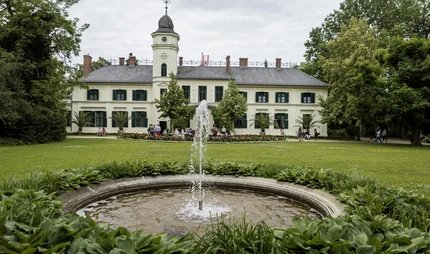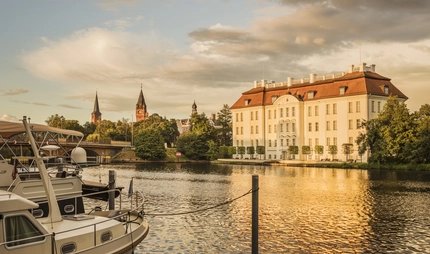
Schloss Friedrichsfelde
The palace at the Tierpark Berlin
From a pleasure palace to a manor farmhouse to a veterinary clinic – that’s the short version of the story of Schloss Friedrichsfelde. Why not pay a visit?
At Schloss Friedrichsfelde you can go on a journey through Berlin’s cultural history. The wallpaper has floral patterns and animal motifs; everywhere there are portraits of famous former inhabitants; lavish showcases contain porcelain from Berlin and glass from Brandenburg; magnificent chandeliers hang from the ceilings. Schloss Friedrichsfelde shows what a luxury residence looked like in the 18th century.
In the course of its history, the palace has been a pleasure palace, a model of modern agriculture and emergency accommodation for animals, as well as a quarter for French soldiers and a prison for the deposed king of Saxony.
In the "History Room" of the east wing, there is a new permanent exhibition: both the 400-year history of the castle is presented and visitors are given exciting insights into the history of Berlin - starting in 1237 with the first documented mention of Cölln, one of the two cities from which Berlin developed. Furthermore, the exhibition focuses on historical milestones of Friedrichsfeld Palace in the following centuries: its architectural history, looting, decline and reconstruction.
The start of construction in the 17th century
If you notice any similarity to nearby Schloss Köpenick, it’s because Schloss Friedrichsfelde is also the work of the architect Johann Arnold Nering. Building began here in 1695, just a few years after Schloss Köpenick was completed. The Dutchman Benjamin Raule been given the plot of land in Rosenfelde (now known as Friedrichsfelde) by Elector Friedrich Wilhelm of Brandenburg in recognition of his services as general director of the Brandenburg navy. Raule used this royal reward to build a pleasure palace in the style of a Dutch manor house.
Conversion in the 18th and 19th century
The naval director only lived in Schloss Rosenfelde for three years before he fell out of favour and the estate returned to the Hohenzollern family. In honour of Friedrich Wilhelm, who died in 1688, Schloss Rosenfelde was renamed Friedrichsfelde in 1699. In 1717, the estate was again given away as a gift – this time to Margrave Albrecht Friedrich of Brandenburg-Schwedt. He widened the palace and introduced Baroque elements such as the balustrade. The palace changed hands several times during the century, and each owner made alterations to the exterior and interior. From 1785, Peter von Biron, the Duke of Courland, redesigned the interior in the Early Neoclassical style, and the outer façade was remodelled from 1800 by Duchess Catherine of Holstein-Beck, a relation of the tsars who played host to high-ranking members of the Russian royal family at Friedrichsfelde.
After 1816: a farm, a veterinary clinic and a zoo
The palace’s time as a residence for royals and courtiers ended in 1816 when it was bought by the Treskow family. Carl von Treskow established a modern farm here based on Albrecht Thaer’s agricultural theories. In 1821 the landscape gardener Peter Joseph Lenné was called in to design the park, and his work is still recognisable today.
After the second world war, Schloss Friedrichsfelde was confiscated from the Treskow family and its rooms looted by Soviet troops. When the Tierpark zoo was established in 1955, the palace became part of it, serving as the administrative office, animal accommodation and a veterinary clinic. It was extensively renovated between 1970 and 1981 to remove the many signs of wear and tear from its various uses and restore its former glory.
Restored to its former glory
Today, the appearance of the Palace is that of an Early Neoclassical 18th century residence. Portraits of its former residents hang in the corridors and exquisite Neoclassical porcelains can be seen in display cases.
Visitors are regularly invited to first-class classical concerts in the ballroom. There is a zoological exhibition, as well as an exhibition on the history of the palace and its very different inhabitants.
Clues:
- for concerts and events, the castle closes 90 minutes before the event begins
- the Tierpark entrance fee also entitles you to visit the Palace, no additional entrance fee is charged
- the castle can also be visited without a guide



